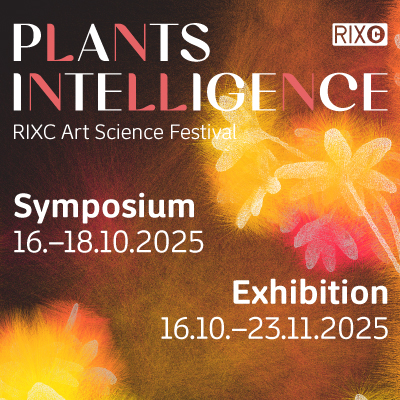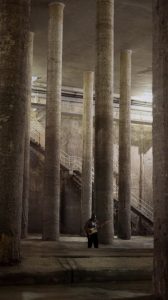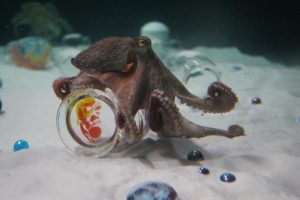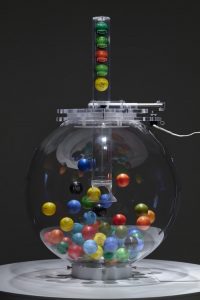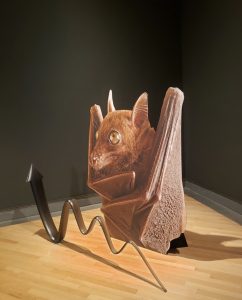Anyone visiting LABoral Art and Industrial Creation Centre before September 7 will get face to face with a mysterious installation by young artist Félix Luque Sánchez. Chapter I: The Discovery is an impenetrable, geometric object and a series of videos restaging the moment of its discovery, as if it were a scene from a sci-fi movie, where the hero is suddenly confronted with an alien, slightly chilling figure.
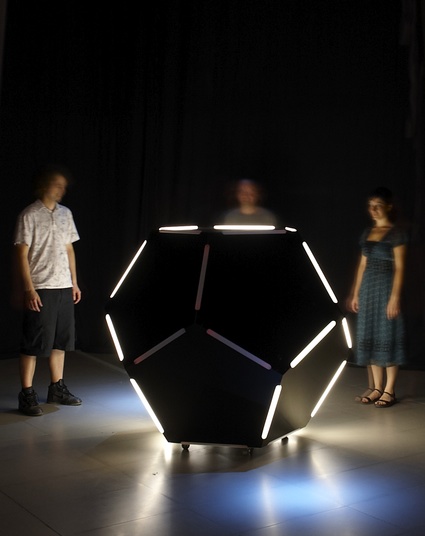 Credit photo Marcos Morilla for Laboral
Credit photo Marcos Morilla for Laboral
The videos are broadcast in the first room. Images show the dodecahedron in places which are fictitious and devoid of any human trace. No matter the context, the alien entity reproduces the same light and sound animation, expressing a state of waiting by emitting a signal of presence. The sculpture itself waits for visitors in the second room. As the viewer gets closer, the machine detects the movement and “tries” to engage in communication made entirely of light and sound code. If the sculpture is surrounded on all its vertical faces, it will respond by releasing its maximum energy.
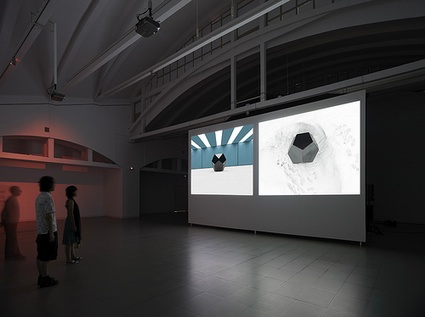 Credit photo Marcos Morilla for Laboral
Credit photo Marcos Morilla for Laboral
Chapter I: The Discovery questions the viewer’s perception about the truthfulness of what is shown, right from the visioning of videos with synthetic images and ending up in an encounter with an interactive object which co-opts information flows, sound and light transmission.
Rather than answering questions–such as, How can technological advances be controlled? On what ethical bases can its purposes be chosen? Who is entitled to decide on the ultimate mission of machines? Can machines destroy us?–this installation, on the contrary, is about reformulating those modern philosophical questions through the use of images associated with the popular culture of science fiction.
Wow! That’s quite a programme!
Video of the installation:
I had to ask Félix for more information about the installation:
Your essay about Chapter 1, the Discovery draws parallels with science-fiction. You mention authors such as Arthur C. Clarke and Philip K. Dick. who are the scifi writers today who, in your opinion, do a similar job of “opening up unforeseen possibilities that are sure to become realities in a very short time”? Don’t you feel sometimes that technological progress is going faster than science-fiction anyway?
First, I have to say that I’m not a SF expert. I am interested in SF because I like the freedom and potential it has to explore its central subject: the relationship between humans and machines, society and technology. A subject that is central for me in digital art. Science fiction is for me a perfect framework for artistic expression with technologies, given that it questions the role of science and technology in the definition of the human.
I think that you could find examples that go both ways. For me Science Fiction mirrors reality in the same way as reality mirrors science fiction. As such, the relationship is confusing, with one continually projecting onto the other.
So what I find very interesting is the fact that being a cultural production, the visions of the present, near or faraway future it makes, are in fact reflections of the society we are living in and its relationship to machines and technologies. We can then use SF to reinvent trajectories crossing the past, present and future of the relationships between man and technologies.
These crossovers are at play in contemporary works. I can think of several examples for now, but there are certainly not the only ones. If you take William Gibson’s Neuromancer (1984), it exalts the now prestigious figure of the hacker and the deep impact of the informatics sciences in our society. Or if you take Crash (1973) by J.G Ballard, there is a hyperrealist approach of the present, without futuristic elements. Existenz (1999) by D.Cronenberg is also a good example presenting an amazing digital art piece about virtual reality and gaming, two subjects very recurrent in the digital art production of the last years. Andrew Niccol’s film Gattaca (1997) constitutes another good example, with an interesting approach about a contemporary social debate: the ethical implications of genetic modifications. Another present question, the effects of climate changes, appears with an apocalyptical vision in the novel The Road (2006) by Cormac McCarthy.
For me, the most interesting things about these works are what they tell us about our present culture, more than what they predict about our future.
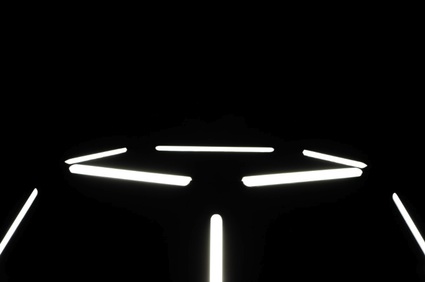 Second Part, The Object (image courtesy the artist). Photo credits: Marcos Morilla for LABoral
Second Part, The Object (image courtesy the artist). Photo credits: Marcos Morilla for LABoral
The description of the work says: “As the viewer gets closer, the machine detects the movement and tries to engage in communication by generating a light and sound code.” Can you give us more details and explain which kind of ‘interaction’ (if that’s indeed an interaction) takes place between the piece and the viewer?
The interaction is very simple : it is one to one. If someone approaches the dodecahedron, the zone facing the visitor detects his presence and reacts to it with a series of lights animations. These series of lights animations change depending on the distance of the visitor from the zone of the dodecahedron.
The object’s code is made by these changes, which generate different light animations resulting in a light-sound code (in the piece sound is made out of the electronic circuits dimming the light tubes).
The importance of the interaction resides in its meanings, which try to convey the idea of artificial intelligence. The interaction is meant to simulate this very complex concept through a language of very simple behaviours.
In order to fully engage with “Chapter 1, the Discover”, how much does the public need to know about the work and the way it functions? Is it necessary to keep some mystery and guessing? Or would you rather communicate as much information about it beforehand?
I think that there is no need to know anything before experiencing the piece. In fact the narration through the whole installation is quite simple. You first enter a room where you watch several videos with different versions of the same moment: the discovery of a strange object in the form of a dodecahedron. Once you move to the second part of the installation, you physically encounter the object, and it reacts to your presence. It tries to communicate.
It’s not important for me if the visitors can read the interaction clearly; I only want them to feel a certain reaction from the object to their presence. By this simple process I hope that people will ask themselves about the meaning and the reality of this experience.
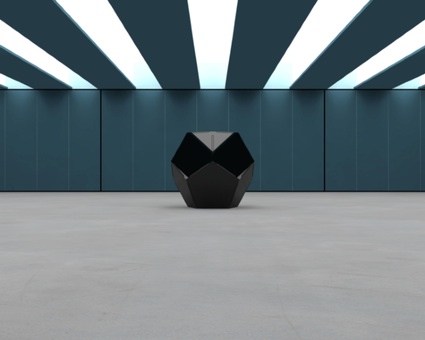 First Part, The Video (image courtesy the artist)
First Part, The Video (image courtesy the artist)
Finally, can you tell us a few words about the aesthetics of the machine? It seems to be quite unfriendly (as opposed to the openly fun, entertaining, playful installations one can see in many media art festivals and exhibitions today), at the point of being slightly alienating?
The object is a representation of a technological alter. The piece explores the concept of alterity from an anthropological point of view: The fear of the other, the exotic, the “primitive” or as in this case the technological other.
The choice of the dodecahedron as a sculptural form is grounded in its symbolism in science fiction and in popular culture in general. My goal is to use the symbolic potential of this figure to favor its conscious or unconscious mental association with images from that popular “subculture”.
The aesthetics of the object resides then in its capacity to become unfamiliar, to make it appear as a machine more than a sculpture. To attend this goal we had to express the apparent simplicity of the form, make disappear the technology, create an indistinct surface, texture, and matter.
Thanks Félix!
Chapter 1, the Discovery is on view at LABoral Art and Industrial Creation Centre in Gijon, Spain, until September 7 , 2009.

